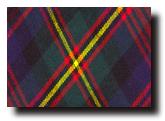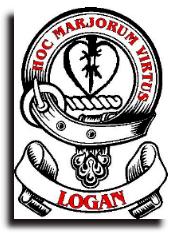
 The Logans in the Highlands are often linked to the MacLennans due to a colourful (but unreliable) legend about a chief of the Logans in Easter Ross who was killed in a feud with the Frasers. His wife gave birth to a child a few months later who later became a priest. His son was named Gillie Fhinnein (disciple of St Finnan) and MacLennan is the anglicised version of this name.
The Logans in the Highlands are often linked to the MacLennans due to a colourful (but unreliable) legend about a chief of the Logans in Easter Ross who was killed in a feud with the Frasers. His wife gave birth to a child a few months later who later became a priest. His son was named Gillie Fhinnein (disciple of St Finnan) and MacLennan is the anglicised version of this name.
All the Logan/Logie names are probably derived from the Gaelic word "lagan" (little hollow) which became parts of place names in various parts of Scotland. One of the most important sources of the name was Logan in Ayrshire but there are examples of the name in Dryburgh in the Borders in 1204, Adam de Logan in Gowrie in 1226 and Thurbrand de Logan in Cunningham, Ayrshire. There were four landowners of that name who signed the "Ragman Roll" of King Edward I in 1296.
Two knights named Logan accompanied Sir James Douglas on his journey to take Robert the Bruce's heart to the Holy Land. They died with Douglas fighting the Moors in Spain in 1329.
There was a landed family of Logans in Forfar, Angus for hundreds of years until the last of the lairds died without issue in 1802. Other Logans were established in lands in West Linton (south of the Pentland Hills in the Scottish Borders).
Sir Robert Logan of Restalrig in Edinburgh married a daughter of King Robert II and was Admiral of Scotland in 1406. The family owned Fast Castle in Berwickshire but they fell from favour and the last Logan of Restalrig died an outlaw and the castle was taken over by the Homes.
Logie/Loggie were located in different parts of the country from Logan. Wauter de Logie also signed the Ragman Roll and Sir John of Logy is reputed to have been one of the nobles who conspired with King Edward II of England and the Earl of Warenne when they attempted an invasion of Scotland in 1320. A coat of arms was granted to Logie of that Ilk (signifying a clan chief) but they were never subsequently recorded in the registers of the Lyon Court.
"The Scottish Gael" was the first work in English to try to give a history of Highland dress and it was written by James Logan in 1831. In modern times, Jimmy Logan is the most famous of a large theatrical family.
The Logan clan motto is "Hoc Marjorum Virtus" which means "This is the valour of my ancestors".
There is a Logan clan Web site here.



